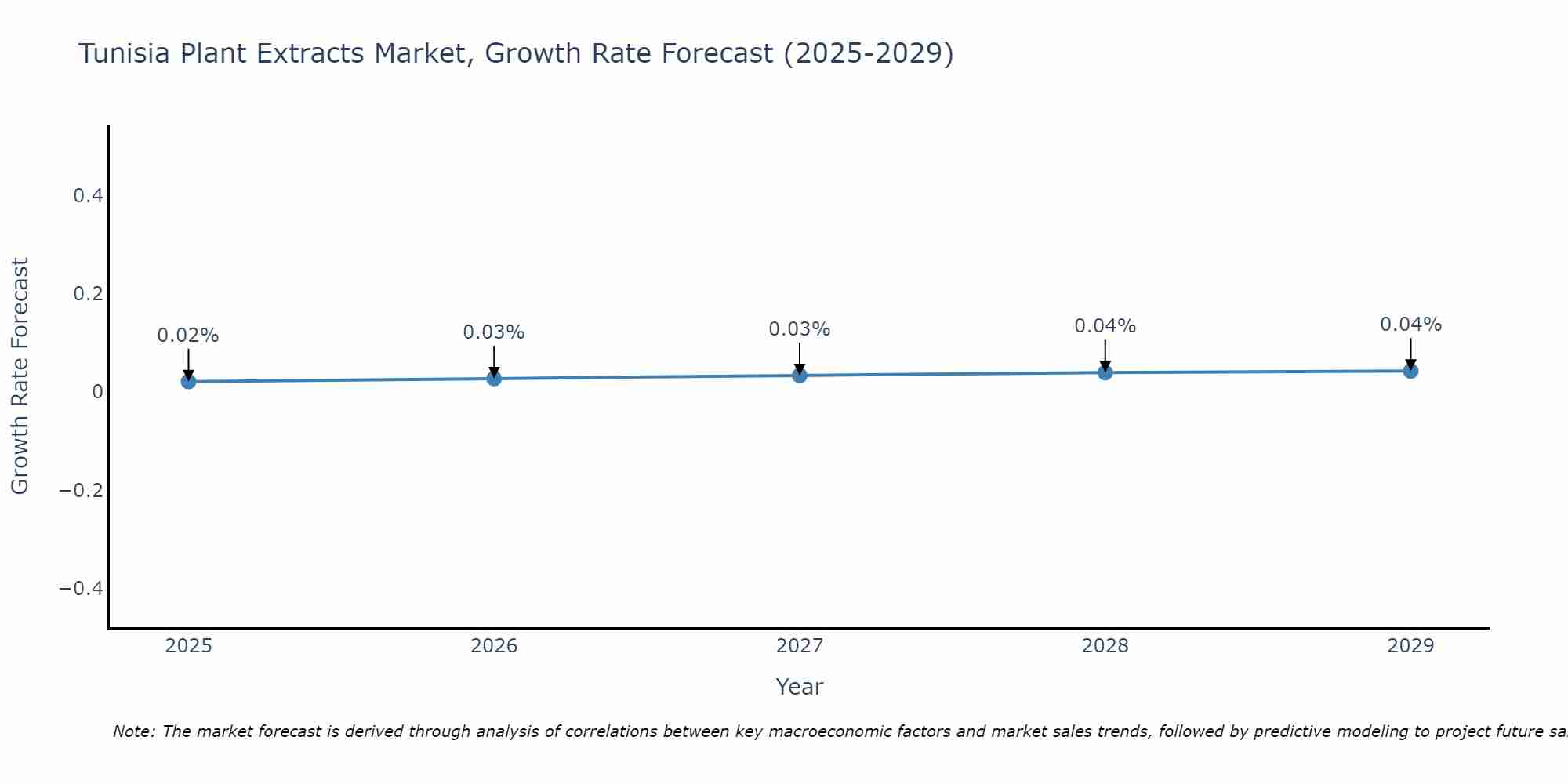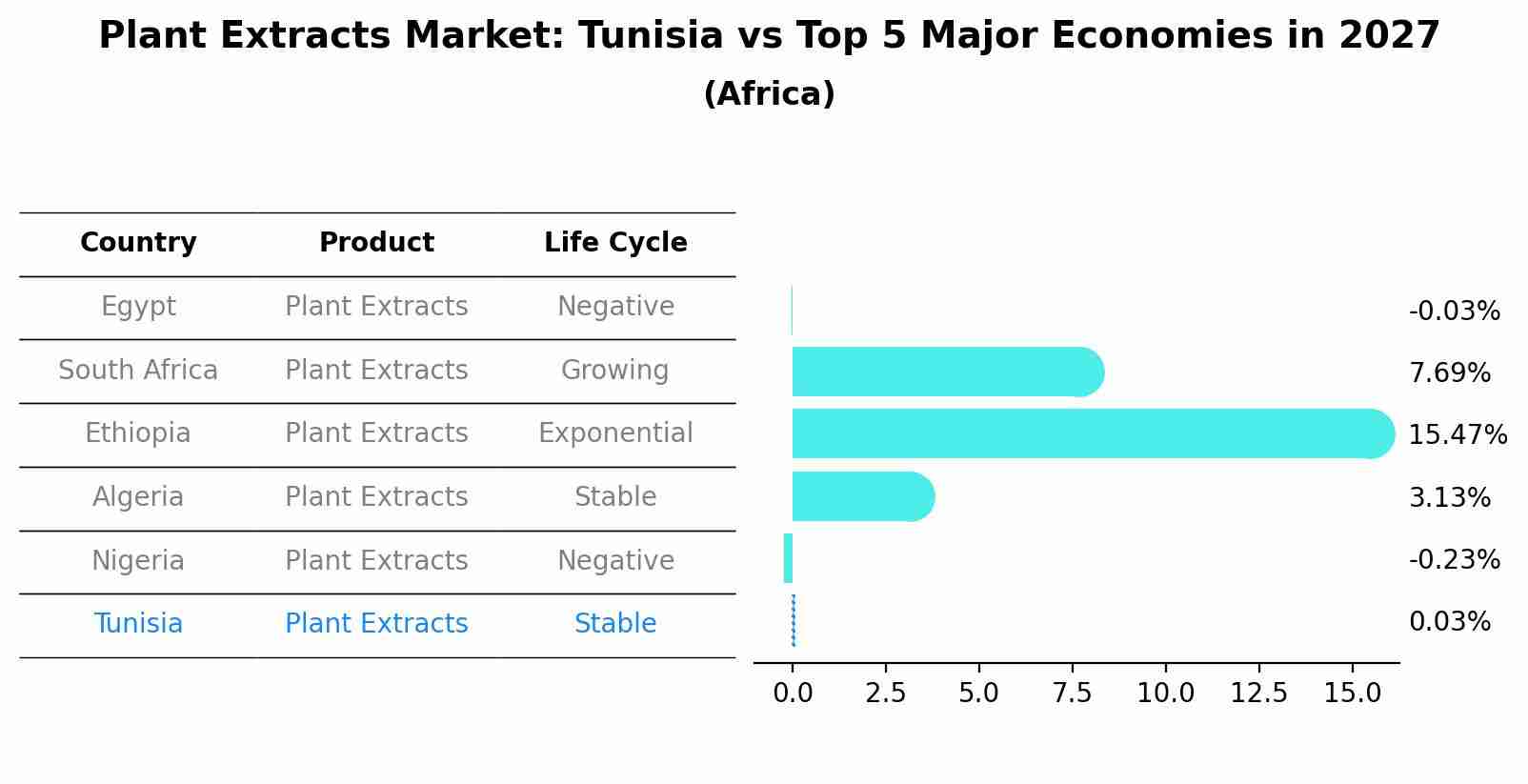Tunisia Plant Extracts Market (2025-2031) | Revenue, Value, Growth, Trends, Size, Share, Companies, Forecast, Analysis, Outlook & Industry
| Product Code: ETC009974 | Publication Date: Oct 2020 | Updated Date: Apr 2025 | Product Type: Report | |
| Publisher: 6Wresearch | Author: Ravi Bhandari | No. of Pages: 70 | No. of Figures: 35 | No. of Tables: 5 |
Tunisia Plant Extracts Market Size Growth Rate
The Tunisia Plant Extracts Market is likely to experience consistent growth rate gains over the period 2025 to 2029. From 0.02% in 2025, the growth rate steadily ascends to 0.04% in 2029.

Plant Extracts Market: Tunisia vs Top 5 Major Economies in 2027 (Africa)
The Plant Extracts market in Tunisia is projected to grow at a stable growth rate of 0.03% by 2027, within the Africa region led by Egypt, along with other countries like South Africa, Ethiopia, Algeria and Nigeria, collectively shaping a dynamic and evolving market environment driven by innovation and increasing adoption of emerging technologies.

Tunisia Plant Extracts Market Overview
In Tunisia, the plant extracts market is expanding due to growing consumer preference for natural and organic products in cosmetics, pharmaceuticals, and food industries. The market is characterized by a rich biodiversity and traditional knowledge of herbal extracts. Companies are leveraging sustainable sourcing practices and investing in research to develop novel plant-derived ingredients.
Drivers of the market
The Tunisia plant extracts market is driven by rising consumer awareness regarding natural health remedies and increasing demand from industries such as pharmaceuticals, cosmetics, and food & beverages. Scientific research supporting the health benefits of plant extracts, along with sustainable sourcing practices, enhances market growth. Innovations in extraction technologies and product diversification also play pivotal roles in market expansion.
Challenges of the market
In Tunisia, the plant extracts market faces challenges related to quality control, sustainability practices, and market competitiveness. Ensuring consistent extract quality amid climate variability and agricultural challenges remains pivotal. Moreover, complying with international regulations and maintaining sustainable harvesting practices are critical for market longevity.
Government Policy of the market
In Tunisia, policies governing the plant extracts market focus on sustainable harvesting practices, biodiversity conservation, and quality control standards. Government initiatives include supporting organic farming methods, establishing certification schemes for botanical extracts, and promoting research into the medicinal and aromatic properties of indigenous plants.
Key Highlights of the Report:
- Tunisia Plant Extracts Market Outlook
- Market Size of Tunisia Plant Extracts Market, 2024
- Forecast of Tunisia Plant Extracts Market, 2031
- Historical Data and Forecast of Tunisia Plant Extracts Revenues & Volume for the Period 2021-2031
- Tunisia Plant Extracts Market Trend Evolution
- Tunisia Plant Extracts Market Drivers and Challenges
- Tunisia Plant Extracts Price Trends
- Tunisia Plant Extracts Porter's Five Forces
- Tunisia Plant Extracts Industry Life Cycle
- Historical Data and Forecast of Tunisia Plant Extracts Market Revenues & Volume By Product Type for the Period 2021-2031
- Historical Data and Forecast of Tunisia Plant Extracts Market Revenues & Volume By Spices for the Period 2021-2031
- Historical Data and Forecast of Tunisia Plant Extracts Market Revenues & Volume By Essential oils for the Period 2021-2031
- Historical Data and Forecast of Tunisia Plant Extracts Market Revenues & Volume By Flavors & fragrances for the Period 2021-2031
- Historical Data and Forecast of Tunisia Plant Extracts Market Revenues & Volume By Phytomedicines & herbal extracts for the Period 2021-2031
- Historical Data and Forecast of Tunisia Plant Extracts Market Revenues & Volume By Applications for the Period 2021-2031
- Historical Data and Forecast of Tunisia Plant Extracts Market Revenues & Volume By Pharmaceuticals & dietary supplements for the Period 2021-2031
- Historical Data and Forecast of Tunisia Plant Extracts Market Revenues & Volume By Food & beverages for the Period 2021-2031
- Historical Data and Forecast of Tunisia Plant Extracts Market Revenues & Volume By Cosmetics for the Period 2021-2031
- Historical Data and Forecast of Tunisia Plant Extracts Market Revenues & Volume By Others for the Period 2021-2031
- Historical Data and Forecast of Tunisia Plant Extracts Market Revenues & Volume By Source Types for the Period 2021-2031
- Historical Data and Forecast of Tunisia Plant Extracts Market Revenues & Volume By Leaves for the Period 2021-2031
- Historical Data and Forecast of Tunisia Plant Extracts Market Revenues & Volume By Fruits, Flowers, and Bulbs for the Period 2021-2031
- Historical Data and Forecast of Tunisia Plant Extracts Market Revenues & Volume By Rhizomes & roots for the Period 2021-2031
- Historical Data and Forecast of Tunisia Plant Extracts Market Revenues & Volume By Barks & stems for the Period 2021-2031
- Historical Data and Forecast of Tunisia Plant Extracts Market Revenues & Volume By Others for the Period 2021-2031
- Tunisia Plant Extracts Import Export Trade Statistics
- Market Opportunity Assessment By Product Type
- Market Opportunity Assessment By Applications
- Market Opportunity Assessment By Source Types
- Tunisia Plant Extracts Top Companies Market Share
- Tunisia Plant Extracts Competitive Benchmarking By Technical and Operational Parameters
- Tunisia Plant Extracts Company Profiles
- Tunisia Plant Extracts Key Strategic Recommendations
Frequently Asked Questions About the Market Study (FAQs):
1 Executive Summary |
2 Introduction |
2.1 Key Highlights of the Report |
2.2 Report Description |
2.3 Market Scope & Segmentation |
2.4 Research Methodology |
2.5 Assumptions |
3 Tunisia Plant Extracts Market Overview |
3.1 Tunisia Country Macro Economic Indicators |
3.2 Tunisia Plant Extracts Market Revenues & Volume, 2021 & 2031F |
3.3 Tunisia Plant Extracts Market - Industry Life Cycle |
3.4 Tunisia Plant Extracts Market - Porter's Five Forces |
3.5 Tunisia Plant Extracts Market Revenues & Volume Share, By Product Type, 2021 & 2031F |
3.6 Tunisia Plant Extracts Market Revenues & Volume Share, By Applications, 2021 & 2031F |
3.7 Tunisia Plant Extracts Market Revenues & Volume Share, By Source Types, 2021 & 2031F |
4 Tunisia Plant Extracts Market Dynamics |
4.1 Impact Analysis |
4.2 Market Drivers |
4.3 Market Restraints |
5 Tunisia Plant Extracts Market Trends |
6 Tunisia Plant Extracts Market, By Types |
6.1 Tunisia Plant Extracts Market, By Product Type |
6.1.1 Overview and Analysis |
6.1.2 Tunisia Plant Extracts Market Revenues & Volume, By Product Type, 2021-2031F |
6.1.3 Tunisia Plant Extracts Market Revenues & Volume, By Spices, 2021-2031F |
6.1.4 Tunisia Plant Extracts Market Revenues & Volume, By Essential oils, 2021-2031F |
6.1.5 Tunisia Plant Extracts Market Revenues & Volume, By Flavors & fragrances, 2021-2031F |
6.1.6 Tunisia Plant Extracts Market Revenues & Volume, By Phytomedicines & herbal extracts, 2021-2031F |
6.2 Tunisia Plant Extracts Market, By Applications |
6.2.1 Overview and Analysis |
6.2.2 Tunisia Plant Extracts Market Revenues & Volume, By Pharmaceuticals & dietary supplements, 2021-2031F |
6.2.3 Tunisia Plant Extracts Market Revenues & Volume, By Food & beverages, 2021-2031F |
6.2.4 Tunisia Plant Extracts Market Revenues & Volume, By Cosmetics, 2021-2031F |
6.2.5 Tunisia Plant Extracts Market Revenues & Volume, By Others , 2021-2031F |
6.3 Tunisia Plant Extracts Market, By Source Types |
6.3.1 Overview and Analysis |
6.3.2 Tunisia Plant Extracts Market Revenues & Volume, By Leaves, 2021-2031F |
6.3.3 Tunisia Plant Extracts Market Revenues & Volume, By Fruits, Flowers, and Bulbs, 2021-2031F |
6.3.4 Tunisia Plant Extracts Market Revenues & Volume, By Rhizomes & roots , 2021-2031F |
6.3.5 Tunisia Plant Extracts Market Revenues & Volume, By Barks & stems, 2021-2031F |
6.3.6 Tunisia Plant Extracts Market Revenues & Volume, By Others , 2021-2031F |
7 Tunisia Plant Extracts Market Import-Export Trade Statistics |
7.1 Tunisia Plant Extracts Market Export to Major Countries |
7.2 Tunisia Plant Extracts Market Imports from Major Countries |
8 Tunisia Plant Extracts Market Key Performance Indicators |
9 Tunisia Plant Extracts Market - Opportunity Assessment |
9.1 Tunisia Plant Extracts Market Opportunity Assessment, By Product Type, 2021 & 2031F |
9.2 Tunisia Plant Extracts Market Opportunity Assessment, By Applications, 2021 & 2031F |
9.3 Tunisia Plant Extracts Market Opportunity Assessment, By Source Types, 2021 & 2031F |
10 Tunisia Plant Extracts Market - Competitive Landscape |
10.1 Tunisia Plant Extracts Market Revenue Share, By Companies, 2024 |
10.2 Tunisia Plant Extracts Market Competitive Benchmarking, By Operating and Technical Parameters |
11 Company Profiles |
12 Recommendations |
13 Disclaimer |
- Single User License$ 1,995
- Department License$ 2,400
- Site License$ 3,120
- Global License$ 3,795
Search
Thought Leadership and Analyst Meet
Our Clients
Related Reports
- Canada Oil and Gas Market (2026-2032) | Share, Segmentation, Value, Industry, Trends, Forecast, Analysis, Size & Revenue, Growth, Competitive Landscape, Outlook, Companies
- Germany Breakfast Food Market (2026-2032) | Industry, Share, Growth, Size, Companies, Value, Analysis, Revenue, Trends, Forecast & Outlook
- Australia Briquette Market (2025-2031) | Growth, Size, Revenue, Forecast, Analysis, Trends, Value, Share, Industry & Companies
- Vietnam System Integrator Market (2025-2031) | Size, Companies, Analysis, Industry, Value, Forecast, Growth, Trends, Revenue & Share
- ASEAN and Thailand Brain Health Supplements Market (2025-2031) | Strategy, Consumer Insights, Analysis, Investment Trends, Opportunities, Growth, Size, Share, Industry, Revenue, Segments, Value, Segmentation, Supply, Forecast, Restraints, Outlook, Competition, Drivers, Trends, Demand, Pricing Analysis, Competitive, Strategic Insights, Companies, Challenges
- ASEAN Bearings Market (2025-2031) | Strategy, Consumer Insights, Analysis, Investment Trends, Opportunities, Growth, Size, Share, Industry, Revenue, Segments, Value, Segmentation, Supply, Forecast, Restraints, Outlook, Competition, Drivers, Trends, Demand, Pricing Analysis, Competitive, Strategic Insights, Companies, Challenges
- Europe Flooring Market (2025-2031) | Outlook, Share, Industry, Trends, Forecast, Companies, Revenue, Size, Analysis, Growth & Value
- Saudi Arabia Manlift Market (2025-2031) | Outlook, Size, Growth, Trends, Companies, Industry, Revenue, Value, Share, Forecast & Analysis
- Uganda Excavator, Crane, and Wheel Loaders Market (2025-2031) | Strategy, Consumer Insights, Analysis, Investment Trends, Opportunities, Growth, Size, Share, Industry, Revenue, Segments, Value, Segmentation, Supply, Forecast, Restraints, Outlook, Competition, Drivers, Trends, Demand, Pricing Analysis, Competitive, Strategic Insights, Companies, Challenges
- Rwanda Excavator, Crane, and Wheel Loaders Market (2025-2031) | Strategy, Consumer Insights, Analysis, Investment Trends, Opportunities, Growth, Size, Share, Industry, Revenue, Segments, Value, Segmentation, Supply, Forecast, Restraints, Outlook, Competition, Drivers, Trends, Demand, Pricing Analysis, Competitive, Strategic Insights, Companies, Challenges
Industry Events and Analyst Meet
Whitepaper
- Middle East & Africa Commercial Security Market Click here to view more.
- Middle East & Africa Fire Safety Systems & Equipment Market Click here to view more.
- GCC Drone Market Click here to view more.
- Middle East Lighting Fixture Market Click here to view more.
- GCC Physical & Perimeter Security Market Click here to view more.
6WResearch In News
- Doha a strategic location for EV manufacturing hub: IPA Qatar
- Demand for luxury TVs surging in the GCC, says Samsung
- Empowering Growth: The Thriving Journey of Bangladesh’s Cable Industry
- Demand for luxury TVs surging in the GCC, says Samsung
- Video call with a traditional healer? Once unthinkable, it’s now common in South Africa
- Intelligent Buildings To Smooth GCC’s Path To Net Zero


















